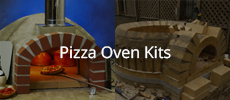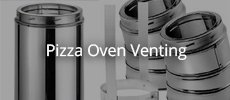Re: 40" Indoor Pompeii in NNY
Yes it is adding mass and will increase the preheat and fuel consumption. I am not sure I consider this a problem though..Neither of those will bother me unless it is on the order of additional hours. Fuel is not an issue here where I am and I work at the house so can start a fire whenever... even if it is just a small fire burning for most of the day to let the heat penetrate and then a bigger fire towards cooking time. I do plan to use the oven for much more than just pizza so I was wanting something with extra mass. I think it will come down to just how much longer, and how much more fuel and I won't really know that until it's in use. And then it will boil down to if it's worth the extra effort on my part.
Darin for sure if the bottom isn't crispy before the top is done the stone/brick isn't hot enough. I get that plenty with my little cooking stone in the gas oven now..From all the posts I have read I thought most have to 'dome' their pizza briefly to brown up the top which would indicate the bottom crust is done first? From my understanding it's more related to the shape of the higher pompeii dome vs a true pizza oven and not brick temperature?
Announcement
Collapse
No announcement yet.
40" Indoor Pompeii in NNY
Collapse
X
-
Re: 40" Indoor Pompeii in NNY
When someone says the pizza top and toppings are done before the crust! We all know what is wrong. Floor not hot enough. Dome too hot.
Leave a comment:
-
Re: 40" Indoor Pompeii in NNY
Like others have said earlier, the thick floor is adding to the thermal mass and going to greatly impact your preheat time and fuel consumption. Check with any of the "pro's" http://www.fornobravo.com/forum/1919-stonecutter/ here that build for a living and ask them their opinion to confirm. I would correct the problem now before proceeding any further.Originally posted by Tonyp View PostThanks for your thoughts John. Well the floor is kinda in already.. I am just a slacker with transferring photos from the camera to the computer and uploading. Anyone aware of pompeii ovens with thicker floors?
Leave a comment:
-
Re: 40" Indoor Pompeii in NNY
If you want a thick floor, why not put another regular floor on top of the first one (laying the bricks the traditional way for both levels)? Removal of the second floor seems easier if desired, and you would be left with a standard floor under it anyway. Just a thought. I haven't built my oven yet, so I am excited to see your results. Thanks and keep posting.
Leave a comment:
-
Re: 40" Indoor Pompeii in NNY
Thanks for your thoughts John. Well the floor is kinda in already.. I am just a slacker with transferring photos from the camera to the computer and uploading. Anyone aware of pompeii ovens with thicker floors?
Regarding the transition area I will look into the way commercial pizzaria ovens vent. I was thinking something along the lines of a funnel shape. Starting out vertical from the floor of the transition area and then angling inward at maybe 45 degrees until narrow enough to place the plate for the round stove pipe connection. That way I should catch smoke that might exit the oven arch more towards the sides. I am making the hemispherical shaped arches so they should tend to push more of the smoke towards the center high point I would think as well.
Tony
Leave a comment:
-
Re: 40" Indoor Pompeii in NNY
If it were me, I'd do it now. Save for a dedicated bread oven, there are no benefits to a floor 5"-thick, only drawbacks. A 2.5"-deep conventional floor with the bricks laying face up reduces the number of exposed seams not to mention the number of cuts required. I might even install an inch of insulating castable on top of your plywood for good measure.If it turns out to take way too long to preheat I can always pull the bricks add some more insulation board and put in a thinner floor
I cut all of my dome and entryway bricks this way. I was lucky to have a contractor saw to work with, but, using patience and plenty of water, you can minimize the deflection. If you're like me and start rushing (after a couple of beers), plan on rotating your blade every dozen bricks or so. What really deflects the blade is contouring (radiusing?) the inside face of your brick by dragging it perpendicular across the blade.By the way if you have ever tried to trim 1/16" off the face of a brick with the wet saw you might discover that the blade wants to deflect off
The big commercial pizzaria ovens have tiny vents that breathe beautifully. I'd copy their design.I will take extra care to make sure no smoke exiting the dome arch bypasses the flue in the transition area
John
Leave a comment:
-
Re: 40" Indoor Pompeii in NNY
Thanks guys for the replies. You are both probably correct. I got a bit carried away with the floor. It is definitely on the experimental side. If it turns out to take way too long to preheat I can always pull the bricks add some more insulation board and put in a thinner floor. One of the other reasons I opted for the floor inside the dome.
Tony
Leave a comment:
-
Re: 40" Indoor Pompeii in NNY
I built mine using the Forno Bravo kit with 2 inch tiles and Fiber Board with 3 inches of Blanket. I can heat up in 90 minutes to 2 hours....that is all fine. The floor cooks perfectly with the right ratio of heat above. It is spec'd that way for a reason and just works/cooks great. I would be careful to go with bricks on edge for fear that sometimes if you don't have time to go the full two hour heat up time etc, you might have pizza with an uncooked bottom.
I am very glad that I used the kit, which kept me to the design that they recommend.
Just more input for you.
Leave a comment:
-
Re: 40" Indoor Pompeii in NNY
I'm no expert and I hope others who are would weight in, but I think having a floor that thick might be a real preheating problem for you. I can more than assure you that you would not have problem with floor temp's dramatically dropping if you would use the recommended firebricks laid flat so you would have a floor 2.5" thick with the proper insulation.Originally posted by Tonyp View Postok floor time! I should preface this with the following: I have been using a 1/2" thick stone in the oven for quite some time. We have a commercial range so I can get it up to about 550f. However it still drives me nuts when you can see the crispiness of the bottom crust fall off a cliff even after 3 or 4 pizzas or flat breads! I want a floor that will hold heat and lots of it! So I am going against the grain here from what it seems most people use for floor thickness and making it 5" thick. I realize it will take a while to heat properly but that's ok.
Tony
It takes me "42 FB plans WFO" somewhere between 90 & 120 mins to get a good preheat going in my WFO, with the floor in the 750-800*F range and the ceiling around a 1000*F. Once my floor has been charged with coals, I have been letting it stabilize a bit before cooking 15-20min. I can cook 8-10 pie in a row without seeing a appreciable dip in floor temp. The beauty is, if it does start to fall a bit, all you have to do is switch sides you're cooking on and shovel the fire to the other side and cook where the fire was. I did a party two weeks ago and did 25 pies without having to move the fire.
Just my 2 cents.
Leave a comment:
-
Re: 40" Indoor Pompeii in NNY
Hi Darin,
Yes that is a very big concern for sure! I have looked closely at many builds to see how the transition into the chimney was constructed. I will take extra care to make sure no smoke exiting the dome arch bypasses the flue in the transition area. The vent pipe goes out the side wall into a 21' tall chimney so total length of chimney pipe is around 26'. It should draft well once it's warmed up. If all works as planned there won't be any smoke out the front except for a brief moment on the initial fire start up. If it becomes an issue I could make a partial outer door to block the upper portion of the outer arch for that first minute or two while the flue warms up. All in all this is a big learning experience and hopefully I have thought of all the potential issues!
Tony
Leave a comment:
-
Re: 40" Indoor Pompeii in NNY
If your landing is small then your vent will be small also, make sure and provide as big of a gap up into your flu as you can. Or as big of an entry is what I mean. Big Flu entry from side to side will really help.
One mistake I made was not providing enough area for the smoke to travel up. I have an 8 inch duravent and I still get a lot of smoke out the front. If mine were indoors, I would be in trouble.
Since yours is indoors and you have a short enty, consider this.
You will not want any smoke coming out the front is the point.
Good luck.
Leave a comment:
-
Re: 40" Indoor Pompeii in NNY
ok floor time! I should preface this with the following: I have been using a 1/2" thick stone in the oven for quite some time. We have a commercial range so I can get it up to about 550f. However it still drives me nuts when you can see the crispiness of the bottom crust fall off a cliff even after 3 or 4 pizzas or flat breads! I want a floor that will hold heat and lots of it! So I am going against the grain here from what it seems most people use for floor thickness and making it 5" thick. I realize it will take a while to heat properly but that's ok. I will have a couple remote probe dial thermometers from Omega in the center floor brick. One will be at the bottom next to the insulation layer and the other will be 1/2" from the inside floor surface. I also plan on the same setup with 2 more thermometers about halfway up the side of the dome. I decided to use the herringbone pattern to minimize seams that might catch a a peel or tool..
Funny though as I am cutting bricks for the floor and quickly realized that brick sizes can actually vary quite considerably! Proceeded in short order by a whole lot of grumbling as the bricks would not line up nicely unless the long sides were 2X the small side, and why couldn't the brick maker at least make bricks to a consistent size and thickness!!! My only recourse was to trim them to the proper sizes! 4.5" x 2.25"...
By the way if you have ever tried to trim 1/16" off the face of a brick with the wet saw you might discover that the blade wants to deflect off. Did you know you can put two blades onto the HF 10" wet saw?
Anyway.. back to the floor. In order to get the thickness I wanted it seemed logical to cut the 9" brick to 5". Then trim to 4.5" x 2.25" and lay them on end, instead of using multiple layers of thinner bricks. The cut off pieces I would just use later in the dome construction..
Photo of the floor construction. If you look closely you will see the two holes in the CalSil board where the temperature probes will come through under the brick. I used silica pool sand under the bricks as I was laying them to help level things out.
Tony1 Photo
Leave a comment:
-
Re: 40" Indoor Pompeii in NNY
Oh Gosh... I have been keeping up with all the various builds from others as well as the many interesting topics on what folks are cooking. I am still working on the oven! No it hasn't collapsed the frame or fallen through the floor into the garage.
There is a sheet of 3/4" plywood over the top of the steel frame. On top of that I put down a 3" thick sheet of cal/sil board and then a sheet of 2" thick board for 5" total thickness. 40" diameter dome with bricks cut in half for 4.5" thick walls. I am really pushing it as big as possible in my corner so I had to cut into the drywall and trim some studs to give 3" clearance to the outside of the dome for insulation. The trimmed studs were reinforced with steel angle iron. The 40" diameter also doesn't give me much room for a landing/entrance so the dome arch is slightly compressed into the front of the oven by about 2"...
I could have made it smaller but I figured if I was going to put all this effort into the project I was going to make it as big as I could in the space given! I do plan to use the oven frequently and for many different tasks besides pizza. Few photos of what's going on with my off the wall build..
First ring of dome bricks (floor will be completely inside the dome so if I should ever need to fix the floor they are removable.)
Working on the 3rd ring which once completed is high enough to start the floor.2 Photos
Leave a comment:
-
Re: 40" Indoor Pompeii in NNY
I have the same concern as David. Your vertical compression strength is fine (13- .75x3.5" boards= ~50000lbs static compressive load capacity). The trouble is transferring the load onto those members. If you can create an anchor for the rebar in your wood structure somehow, I think you'll be fine. I'd also go a bit overkill on the rebar, as well, and maybe go up to 5" slab.
I don't know what all you have planned to finish the oven out, but just the dome is going to be in the 2500lb range and your hearth is probably close to that as well.
Leave a comment:
-
Re: 40" Indoor Pompeii in NNY
Building a large masonry oven over a plywood floor is rather unusual. Most builds start with 4" reinforced concrete. Obviously you've done your calculations so I wish you well. For my ovens, if I use a steel stand it is made from 50 mm x 50 x 4mm steel angle, substantially more than yours, with a span of only 670 mm which supports an oven supporting slab of 910 mm x 910 mm and my oven weighs only 250 Kg. The first steel stand I built was made from lighter weight steel square box section 20 mm x20 mm x 1.6 mm of the same dimensions and I felt it required stronger material as there was too much flexing.Last edited by david s; 05-26-2014, 08:08 AM.
Leave a comment:





Leave a comment: